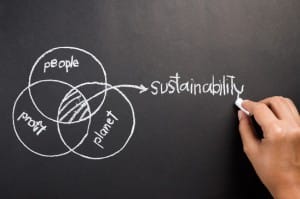Toward fully informed water-sensitive communities
The importance of environmental “literacy”
 As with most environmental concerns, water sensitivity can be greatly enhanced by the trust and support of communities. Over the past few decades, with the looming challenges of climate change, people have increasingly become aware of their own individual impact on the environment. Words like “sustainability” and “carbon footprint” are part of the common vernacular; and dinner party conversation frequently turns to environmental debate – such as the energy efficiency of turning lights off when one leaves the room for just a minute.
As with most environmental concerns, water sensitivity can be greatly enhanced by the trust and support of communities. Over the past few decades, with the looming challenges of climate change, people have increasingly become aware of their own individual impact on the environment. Words like “sustainability” and “carbon footprint” are part of the common vernacular; and dinner party conversation frequently turns to environmental debate – such as the energy efficiency of turning lights off when one leaves the room for just a minute.
This “climate literacy” is a wonderful thing culturally, but it is also crucial in effectively tackling climate change. Many large institutions, Monash University for example, have “gone green” with measures to maximise energy efficiency and generally reduce their environmental footprint. This would not be possible without the community’s increasing readiness to support environmentally sensitive policy.
“Water sensitivity” is our concern …
Compared to climate change, water seems a less sexy topic, which is both a blessing and a curse. Climate change is a complex global and intergenerational challenge, with layers of competing values that have been championed by various political parties. While the politicisation of climate change has put it front and centre in the public eye, it has also led to misinformation and outright denial of the problem. By comparison, “water sensitivity” is barely politicised at all, which means that lack of information is among the problems, rather than misinformation.
That’s where Associate Professor Kelly Fielding and her research team come in. Kelly oversees Societal Innovation and Behaviour Change (Project A2) at the CRC for Water Sensitive Cities (CRCWSC). A central tenet of Kelly’s work is that community can play a crucial role in the development and implementation of water sensitive policy (as we have seen with climate policy). “Knowledge is power,” she argues. While not subscribing to a simple information-deficit model, which naively suggests that we just need to inform people and they will act differently, Kelly concludes from her research that “some sort of understanding of how things fit together is important”.
To that end, a national survey has been conducted to determine different Australian communities’ current levels of “water literacy”, as well as their current engagement in water sensitive behaviours. Now that the information has been gathered, Kelly and her team can work on increasing water literacy and engaging communities to adopt and support water sensitive behaviour and policy.
… but what does that mean?
 One of the obstacles to increasing water literacy lies in the way water knowledge is communicated. Initial reports from focus groups reveal that terminology can leave people confused, or even make them switch off. For example, in the field of water sensitivity we often refer to water that is “fit for purpose”: the water for a soccer pitch does not need to be treated to the same extent as water for human consumption. Discussing these different “types” of water led one focus group participant to be concerned about access to drinking water: “But what if that ends up meaning high-quality water only for rich people, average water for middle class people, and poor-quality water for poorer people?” Of course this is not what is intended by that terminology at all. Another participant responded to the phrase “fit for purpose” by saying: “Oh, that’s just Orwellian. It means nothing.”
One of the obstacles to increasing water literacy lies in the way water knowledge is communicated. Initial reports from focus groups reveal that terminology can leave people confused, or even make them switch off. For example, in the field of water sensitivity we often refer to water that is “fit for purpose”: the water for a soccer pitch does not need to be treated to the same extent as water for human consumption. Discussing these different “types” of water led one focus group participant to be concerned about access to drinking water: “But what if that ends up meaning high-quality water only for rich people, average water for middle class people, and poor-quality water for poorer people?” Of course this is not what is intended by that terminology at all. Another participant responded to the phrase “fit for purpose” by saying: “Oh, that’s just Orwellian. It means nothing.”
Tracy Schultz, one of Kelly’s PhD students from the University of Queensland, is investigating whether images can be an effective way to switch the community on, and to overcome possible disengagement through excessively formal delivery. Images are useful as they “can easily be shared through new media”, says Kelly.
Marnie Kikken, Environment and Sustainability Manager for the Ku-ring-gai Council in NSW, is working closely with the CRCWSC and uses social media extensively. The Council engages with people through its online presence – including Twitter, Facebook, and YouTube. “It’s just the way of the future,” says Marnie. “We’re going to be missing the boat in terms of getting our message out there if we’re not using these media, because so many people use them now as their key way of keeping informed.”
The research of Kelly Fielding and her team will determine which terminology, visuals, and new media are most effective for engaging the community in water sensitivity. An informed and engaged community is crucial in supporting water sensitive policy. Marnie is quick to agree. “With the sheer land space occupied by residents and private property, we can’t actually achieve what we want to, in terms of water quality and conservation, without bringing the community on board,” she points out, drawing on catchment studies in the Ku-ring-gai Local Government Area. “Much of what we’re trying to achieve would need to take place on private property, so it’s essential that we have community and council initiatives working hand in hand.”
Community understanding and behaviour change
Marnie has worked closely with Associate Professor Liam Smith, who leads the CRCWSC’s Accelerating transitions to water sensitive cities by influencing behaviour (Project A2.2). This focus on behaviour change works well in tandem with Kelly’s focus on water literacy. Once people understand what is at stake, there is often significant behaviour change. After Australia’s substantial drought in recent years, which Kelly notes as an example, residents have come to understand that “things they do in the house have downstream impacts for water conservation”. Motivated and engaged in the issue, their choice to take shorter showers demonstrates water sensitive behaviour change.
Liam’s research aims to take these literate and engaged water sensitive behaviours further. He is looking for connections between different behaviours (what he calls “spillover”), so that we can tap into people’s intrinsic motivators. In other words, if people already show motivation with quick showers, it may not take much to go from this to using a bucket in the shower to catch water, or turning off the tap when brushing teeth. “We’re not just wanting people to implement one thing, and then walk away,” says Marnie. “We want people to feel like ‘I have done this thing, and therefore maybe I can do this next thing.’ We want to take people on that kind of journey.”
Understanding the community
To enable this journey, understanding must go both ways: we cannot take the community on a journey without knowing how it got here. “More than 200 years of building and urban cultural preferences cannot easily be undone,” says Associate Professor Jo Lindsay, leader of Understanding social processes to achieve water sensitive futures (Project A2.1). “We want to take people along on this journey to sustainability rather than be seen to impose it upon them.” Jo’s project will be crucial in placing Liam and Kelly’s work in a historical and social context. By studying why Australians currently use water as they do, she hopes to “better inform future policy agendas”.
So in the end, past and present merge: once understood, historical and current ways of using and thinking about water will help Kelly’s team to identify a path toward engaged and fully informed water-sensitive communities.
Sam Green for the Mind Your Way team